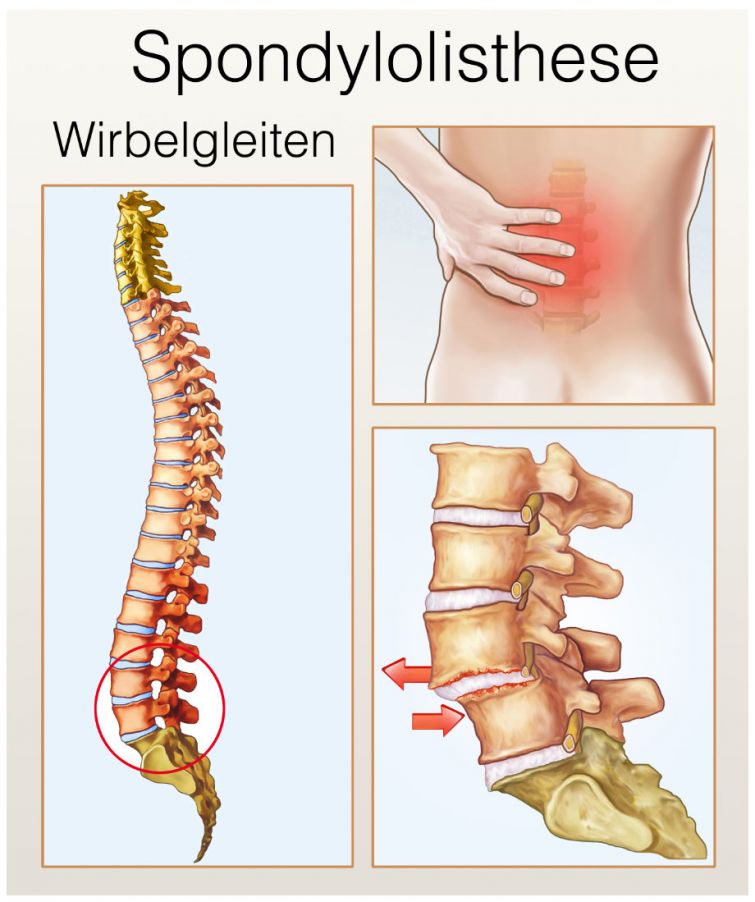Spondylolisthesis (slipped vertebrae) is a condition in which the vertebral bodies of the spinal column shift against each other. Most often, spondylolisthesis occurs in the lumbar spine. In severe cases, individual vertebral bodies can even pinch the spinal nerves in the lower spinal cord. The pinching of nerves often causes considerable pain or sensorimotor deficits.
Vertebral slipping over a long period of time causes adhesions in the posterior vertebral region. This allows the statics of the spine to partially strengthen and thus stabilize itself.
Many patients also feel no discomfort at all due to spondylolisthesis. This is referred to as asymptomatic spondylolisthesis, i.e., spondylolisthesis without symptoms.
Patients with symptomatic spondylolisthesis can be severely limited in their mobility. In some cases, they suffer from severe pain depending on the load on and position of the back.
In most cases, the symptoms can be treated conservatively (without surgery). Surgery is only necessary in very severe cases of spondylolisthesis.
The attending physician decides whether treatment is necessary. The indication for surgical treatment always depends on
- The pain,
- The restriction on everyday activities and the quality of life,
- The subjective psychological stress, and
- The clinical-radiological set of findings.

In spondylolisthesis, individual vertebrae shift relative to adjacent vertebrae © Henrie | AdobeStock
The physician responsible for diagnosing spondylolisthesis is a spine specialist (usually a neurosurgeon or orthopedist).
Necessary operations are performed by the specialist in neurosurgery, orthopedics, or trauma surgery.
The spine carries the whole load of the body and it keeps it upright. In case of excessive loads, a vertebra can slip. This happens especially if
- The muscular system,
- The joints, and
- The ligaments
are weakened.
The most common cause is degenerative damage to the vertebrae. With age, there is a loss of fluid in the intervertebral discs, which reduces their height. The vertebral bodies converge and the function of the muscular and ligamentous structure is impaired. In untrained people, this leads to poorer compensation for disc damage.
Excessive strain and backward hyperextension of the spine can cause isthmic spondylolisthesis. Weightlifters and javelin throwers are affected particularly often. Injuries to the spine also reduce its stability and may cause disease.
In some cases, the disease is congenital. The triggers for this are still relatively unknown. However, there are familial clusters. This means that first-degree relatives of an affected person have an increased risk of also developing the disease.
Boys are three to four times more likely to be affected than girls. However, progression is more pronounced in girls.
According to the German Society for Orthopedics and Orthopedic Surgery, up to forty percent of Germans are affected by spondylolisthesis. However, the expression is often mild.
Affected patients often suffer from pain that intensifies with certain movements. This pain often spreads from back to front and feels like a belt. Some affected persons also have the feeling of a certain spinal instability.
The pain is more severe when the back muscles are relaxed in the morning. When a nerve root is crushed, sensory and/or motor impairment may also occur in the legs.
A brief overview of the symptoms:
- Back pain, which sometimes radiate into the legs as well,
- An unpleasant feeling of weakness in the legs, and
- Numbness in the legs.
If the disease is far advanced, it can also lead to
- Restricted mobility in the lumbar spine,
- Paralysis, and
- Rectal and bladder dysfunction in severely advanced spondylolisthesis with spinal cord restriction.
However, these are rather exceptional cases.
In some cases, spondylolisthesis remains symptom-free. The therapy should be discussed with the doctor. Treatment might be unnecessary as long as there is no pain.
Anyone who frequently suffers from back pain should consult their primary care physician. If spondylolisthesis is suspected, they will refer their patient to a spine specialist.
Only in rare cases is spondylolisthesis an emergency that must be treated immediately in a clinic. Emergencies that need to be investigated immediately are
- A severe sensory or motor impairment and
- Problems with urination or defecation.
The anamnesis, i.e., the patient consultation, is at the beginning of the diagnostic process. The doctor will inquire about the symptoms and medical history:
- Is there a spinal injury?
- What sports does the patient participate in?
- Are there similar symptoms known in the family?
- Is the pain related to movement?
- Is there a feeling of instability in the spine?
- Have motor or sensory impairments been noticed?
This is followed by a physical exam.
Physical exam
The physician now checks the patient's mobility. They pay attention to whether the affected person is bracing themself or appears unsteady.
They also examine the course of the spine. Deformities are conspicuous, for example, an S-shaped course, which indicates scoliosis. A "step-off sign" can also be detected if a hump is seen in the course of the spine. Such stages are usually detected by palpation of the spinous processes (posterior processes of the vertebrae).
By pressing and tapping, the doctor identifies painful regions. The position of the pelvis and the muscle status around the spine are also checked during the examination.
What is known as the Schober’s test can be used to check the function of the spine. To do this, the examiner marks a spot every ten centimeters, starting from the angle of the upper coccyx. If the patient leans forward, the doctor recognizes the limitation of mobility.
Even more specific examinations depend on the patient's symptoms.
Imaging examinations
In order to get an accurate picture of the disease, X-ray images are taken from two different planes. Sometimes the doctor also requests
to be performed. This allows the intervertebral discs and bones to be assessed more accurately.
To assess whether a dynamic slipped vertebra is present, conventional images of the lumbar function when inclining and reclining the back are often useful as well.
According to Meyerding, spondylolisthesis is classified into four different degrees of severity.
- Grade I: the vertebrae shift up to 25%
- Grade II: the vertebrae shift between 25% to 50%
- Grade III: the vertebrae shift from 51% up to 75%
- Grade IV: the vertebrae shift over 75%
If a vertebra becomes completely detached, this is called spondyloptosis.
Symptoms and complaints also occur depending on the severity. With early treatment, the prospects of relief from symptoms are very good.
The main goal is to relieve the sufferer of pain and thus ensure a better quality of life. This is achieved by stabilizing the vertebrae.
Spondylolisthesis therapy consists of two cornerstones:
- Conservative treatment and
- Surgical treatment if conservative therapy is not sufficient.
In milder cases, conservative therapy is usually sufficient. Direct surgical intervention only has to be considered in very severe cases.
What is the conservative treatment?
First, a detailed consultation is conducted after thorough examinations. In this process, the doctor explains to the patient how they can relieve their spine in a targeted manner. In most cases, this alone leads to a significant improvement in the symptoms.
The patient must avoid overextending the spine through certain sports. Correspondingly, losing weight is recommended for overweight patients. This reduces the load on their spine.
In addition, medication can help. Various painkillers can be used effectively against the pain. Muscle relaxers and anti-inflammatory medications are also available.
Physiotherapy
A strong musculature that counteracts spondylolisthesis guarantees a stable spine.
The best way to achieve this is through targeted gymnastics and, above all, through regular daily exercises to train the back muscles.
Neurosurgery
Surgical intervention is necessary only in very severe cases. Surgery stabilizes the vertebrae to ensure their correct position. An appropriate consultation provides information and assuages the fears that exist before surgical therapy.












































